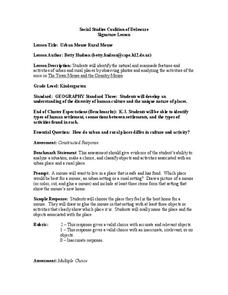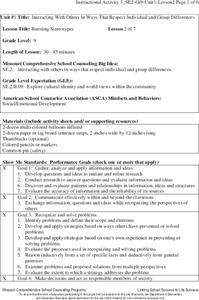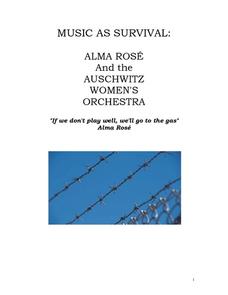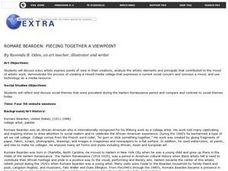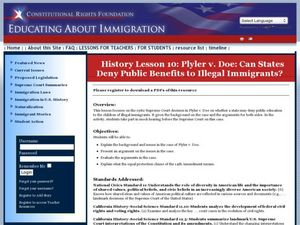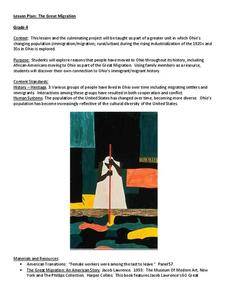Curated OER
National and Regional Identity
Learners examine state quarters to identify symbols that represent national and regional identity. They discuss the process used to determine what is put on the quarter. They review colonial money, and euros to look for cultural images.
Curated OER
Whose Religion Is It?
Learners analyze the impacts of religious expectations on gender roles. In this gender equity instructional activity, students compare and contrast different religions in societies in order to understand the cultural influences and...
Social Studies Coalition of Delaware
Urban Mouse Rural Mouse
Explore rural and urban environments over the course of four days. Each day offers a new look into how both environment compare and contrast. Activities include the observation and analyzation of images, a read aloud and grand discussion...
Learning to Give
The Beginning of the Storm
Introduce readers to Mildred Taylor's Roll of Thunder, Hear My Cry with a lesson that sets the context for the novel. Class members research the bigotry in Mississippi during the Great Depression and identify examples in the story of how...
National Park Service
What Can We Do?
Motivate young conservationists to stand up and make a change. After learning about the efforts in Cascade Nation Park to reduce carbon emissions in order to preserve the wilderness, students work in groups creating action plans for...
Missouri Department of Elementary
Bursting Stereotypes
Balloons take on the role of stereotypes in an activity that asks high school freshman to generate a list of different adjectives that are frequently used to describe men and women. Then then attach a stereotypical label to a balloon and...
Curated OER
Establishing a Global Perspective: Do Values Cross Borders?
Twelfth graders explore values in global perspectives. They discuss values in popular films and complete a timeline of their personal, societal, and key events. They design a photograph that reflects the concept of values. They create...
Curated OER
Introduction to World Religions - Christianity
Sixth graders explore Christianity. In this world religions lesson, 6th graders listen to a lecture about the attributes of the religion and then listen to and then conduct independent research on Christianity. Students also complete a...
Curated OER
Music As Survival: Alma Rose and the Auschwitz Women's Orchestra
Students explore a period of European history in which musicians have used theri musical talents and abilities to survive and rise above extremely difficult situations. The psychological uses of music by the Nazis is examined in this...
Curated OER
Metis- Grade 9
Ninth graders investigate aspects of Metis life. In this Canadian history lesson, 9th graders research Metis life and use their findings to create time line quilts.
Curated OER
Romare Bearden: Piecing Together A Viewpoint
Students examine the history of Romare Bearden and her artwork. The lesson consists of some virtual field trips and projects. The lesson is designed to be taught as either a social studies or art lesson. The teacher could also teach this...
Curated OER
Treaties
Students explore Canadian maps. In this map skills and Canadian history instructional activity, students locate reserves that originated from treaties made while establishing the Saskatchewan First Nation reserve communities. Students...
Curated OER
Pictograph Robe Stories
Fourth graders explore the diversity and commonality of human interdependence. Also, the global cooperation of the people of the United States and the world through a multicultural and historical perspective. They describe the...
Curated OER
History Lesson 10: Plyler v. Doe: Can States Deny Public Benefits to Illegal Immigrants?
Students consider the rights of illegal immigrants. In this illegal immigration lesson, students analyze the Supreme Court case Plyler v. Doe and determine whether illegal immigrants should have access to public benefits. Students...
Curated OER
Immigration in the Late 1800's
Seventh graders explore the progression of immigration patterns in the United States. They examine how immigrants perceived and adapted to the United States culture. Students discuss how immigrants were able to perserve their culture in...
Curated OER
Lesson Plan for Korea
Students explore the results when conflicting cultures collide. They observe that often dominant cultures have tried to impose their will on others, with little or not thought about the effects on the people.
Curated OER
Japan: perception, images, myths
Learners compare and contrast American and Japanese social and cultural values, attitudes, characteristics, and patterns of behavior. They identify problems that North Americans have in doing business in Japan. They appreciate the...
Curated OER
Lesson Connections
Second graders listen to, analyze, and describe music. They are assessed as to whether they are distinguishing between A and B sections through different types of music. Students imitate echo, motive, phrase and AB or ABA. Finally,...
Curated OER
Lesson 8: Early History of Illinois/Dual Timeline
Pupils, in groups, research and pretend as if they are interviewing a Mississippian child. They come up with three questions to ask to research their culture.
Curated OER
The Great Migration
What a terrific instructional activity! Have your class learn about immigration using this resource. Fourth graders discuss the Great Migration in Ohio through art, writing, and discussion. Afterward, they create a presentation in which...
Curated OER
Los Angeles Throughout the Years
Fourth graders study the history of the city of Los Angeles, investigating its variety of cultural traditions. They develop expertise on one specific decade in LA history.
Curated OER
American Perceptions of the Wilderness
Students examine various American perspectives about the wilderness over time. In small groups they read and analyze writings by William Bradford and Frederick Law Olmsted, summarize the major points of each author, and write an essay.
Curated OER
"Be the Kiwi" - Bible
Students compare and contrast the English version to the Maori version of the Treaty of Waitangi. In this diversity lesson, students discuss similarities and differences in the two versions of the treaty. Students discuss the effects...
Curated OER
Aboriginal Physical Education
Learners engage in p.e. activities that have roots in native Indian, Metis, and Inuit cultures. They practice the skill involved and listen to the significance behind the skill. They read relevant books and define new terminology.




